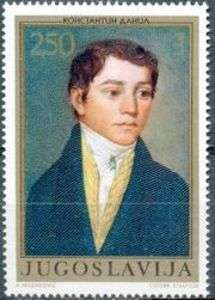Konstantin Danil
.jpg)
Konstantin Danil (Serbian Cyrillic: Константин Данил, Romanian: Constantin Dănilă, 1798-1873) was a renowned Serbian painter of the 19th century. He is most famous for his portraits.
Biography
Constantine Danil Grigorović, better known as Konstantin Danil, was born in Lugoj in a family with Serbian and Romanian roots, in 1798. Danil Grigorović, Konstantin's father, was a Russian officer under the command of Alexander Suvarov who decided to settle in the city in Timis County in Banat (now western Romania) situated on the banks of the Timiș River, then part of the Austrian Military Frontier.
Konstantin Danil's parents intended him for a literary or learned career, however, he very early showed an interest in art, and at the age of thirteen he left Lugoj for Temișvar, where he executed a drawing which procured his admission to the school of Arsenije "Arsa" Teodorović (1767-1826). Teodorović was one of the most significant Serbian painters in the 18th- and 19th- century. Danil's master graduated at the Academy of Arts in Vienna, and afterwards he lived in Temișvar and Novi Sad. He painted portraits and altarpieces, and some historical compositions. His style belonged to a progressive, classicistic stream of Serbian art. Teodorović was a principal of a drawing school, and through it he influenced a whole new generation of younger artists, including a few that rivaled him. One of them was Konstantin Danil. Here Konstantin Danil studied for several years, and produced, among other works, a figure of Saint Sava which attracted much attention. The Serbian master gave every encouragement to the young Konstantin Danil for the next four years. Artists had then already started to call Konstantin Danil Grigorović, who was perpetually sketching all sorts of objects in art and in nature, by his father's name Danil. Konstantin Danil, who had by this time acquired so much mastery over the painting technique that his performances were barely distinguishable from Teodorović's own. He now began to explore other avenues to improve his skills.
At the age of seventeen he left Teodorović and went to the atelier of one of three Viennese academicians, then working in Temișvar. Danil also took lessons from itinerant portrait-painters and afterwards entered as a student in the Academy of Arts in Vienna and in Munich. It was in Vienna and Munich, where he became influenced for a while by the works of classicist German painters Asmus Jacob Carstens, Joachim Christian Reinhart, Peter Fendi, Joseph Anton Koch, Gottlieb Schick and Bonaventura Genelli. He also took time to travel and paint throughout Banat and Erdelj (Transylvania). Danil had tried his skill in every genre—in portraiture, landscape, flower-painting, scenes of modern life and figure subjects; his finest works in portraiture and nature mort (still life) rank among the masterpieces of the modern Serbian school. From Munich Danil returned to Veliki Bečkerek (Zrenjanin), where he resumed the style of Teodorović, and shortly afterwards Veliki Bečkerek, the city in the eastern part of Serbian province of Vojvodina, became his permanent residence.
Danil was yet still obscure, but a rich Hungarian nobleman by the name of Stephen von Karácsony soon discovered in him all the stuff of a successful artist, and gave him his niece Sofia Dely in marriage in 1827. This was another turning point in Danil's fortunes. He painted Karacsony, which Karácsony exhibited to all his powerful associates and admiring visitors to his estate. And when the nobleman became a Viceroy of Banat so too, Konstantin Danil's popularity grew. From the Viceroy and other noblemen commissions now flowed in upon Danil.
Having spent much time in the military frontier, and having been with the Austrian troops in actual warfare, he made a specialty of rendering the Military Frontier officers and bordermen as seen on the Potiska and Pomoriška plains. One such portrait of Captain Kljunović and his wife impressed a Serbian Orthodox priest by the name of Arsenović, who selected Danil to decorate the walls, dome and iconostasis of a new Serbian Orthodox church in Pančevo with figures of saints. Upon complition of his commission (iconostasis) in 1833 Danil received an honorarium of 4,000 silver florins. At the same time he produced a series of designs illustrative of Old Testament history.
From 1834 to 1873 Danil threw himself into the renaissance of Biedermeier and the sacral painting based on the school of Vienna Nazarene movement, and became one of its leaders. He worked in his own atelier at 37 Tsar Dušan Street in Veliki Bečkerek where 14 Serbian artists were apprenticed, including our poet-painter Đura Jakšić and artist Lazar Nikolić, who wrote a biography of his teacher. In 1872 his wife, Sofia Dely, died, and a year later (1873), Danil died at Veliki Bečkerek (Zrenjanin) on 13 May.
Work

His chief pictures are Madonna, Male Portrait, Still Life, Stanci Dely (his father-in-law), Archangel Gabriel, Ms Vaigling, Ms Tetesi, and, best known of all, General Stevan Kničanin and Portrait of Maria (1872). The portraits of his wife Sofia Dely (1840), Petar Jagodić, and A Lady with a Cross are among his best achievements in this class. The National Museum of Serbia at Belgrade contains a vast majority of his work.
Legacy
He will be remembered as a master of technique, and his portraits—in the hundreds—reveal an extraordinary study into the characters of his subjects. Nevertheless, for some time after his death his name was almost forgotten by the public, and it is only in the twentieth century that he has been conceded the position amopng the masters of the modern Serbian school which is his due. Konstantin Danil, by virtue of his early art work in Temișvar, a multi-ethnic city (composed of Romanians, Germans, Hungarians and Serbs), is also claimed by three other nations, Romania, Austria and Hungary, as their own.
He is included in The 100 most prominent Serbs.
External links
- Terminartors.com
- Portrait of Maria at the Wayback Machine (archived February 13, 2006)
- Portrait of Petar Jagodic